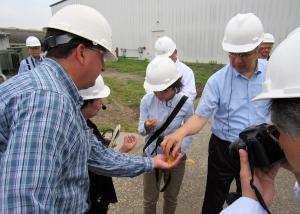The 2017 U.S. Grains Council (USGC) trade team season is in full swing with more than two dozen teams from around the world scheduled to traverse U.S. farm states throughout the summer and fall.
“Trade teams provide truly unique opportunities to help familiarize our international customers with the U.S. grain export system,” said Kimberly Atkins, USGC vice president and chief operating officer. “These face-to-face interactions develop critical connections that open new markets and instill long-term trust in the United States supply chain from the farm to delivery.”
The Council’s trade teams focus on providing a complete look at the U.S. grain or ethanol value chains. As such, they have diverse itineraries that can include visits to seed technology providers, equipment manufacturers, ethanol plants, grain trading companies and transportation facilities in addition to interacting directly with U.S. corn, barley or sorghum farmers.
One such team of craft brewers from Mexico recently completed their trade team visits to Idaho, Montana and Wyoming. The brewers on the team told the Council the trip expanded not only their view of U.S. barley and malt, but also their vision for doing business with U.S. producers.
“We got to see much more about one of our basic ingredients than we ever knew before,” said Alejandro Cortés, the head brewer for Cervecería de Colima, who participated in team activities. “The trip was great in terms of focusing on different parts of barley, from breeding to agronomics and the malthouses as well.”
The ultimate goal of this knowledge gained and these relationships established is increased purchases of U.S. feed grains and co-products. But these outcomes can also build trust with government officials, policy-makers and members of the international press.
A Japanese media team focused on ethanol recently traveled to Washington, D.C., and Nebraska to demonstrate the positive impacts of corn-based ethanol. Like others, members of this trade team took what they learned home to provide better insights and information about U.S. feed grains and co-products.
“By seeing U.S. grain and export systems firsthand, the Council facilitates not only short-term sales, but also long-term, loyal customers,” Atkins said. “Showing the pride that U.S. farmers have in their crops as well as their commitment to provide a high-quality product goes a long way to growing the global grain market.”
Watch Global Update and the Council’s Twitter, Facebook, Instagram and YouTube channels for more coverage of trade teams as they make their way through the U.S. farm country this year.



